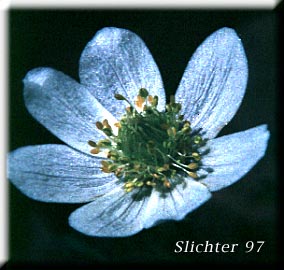 Photo at right of Anemone
drummondii from Broken Top.
Photo at right of Anemone
drummondii from Broken Top.
 Photo at right of Anemone
drummondii from Broken Top.
Photo at right of Anemone
drummondii from Broken Top.
Drummond's anemone is difficult to distinguish from cliff anemone (A. multifida). The former is usually shorter and more cushion-like, less hairy, and with one flowers per stem . The latter is taller, with up to two flowers per stem.
The basal leaves are divided into several elliptical leaflets which are finely and deeply cleft. The blades are 3-4 times ternate with segments less than 2 mm wide. The basal leaves also have long petioles. A whorl of leaves is found at midstem in addition. These latter stem leaves lack the long petioles.
The flowers are actually 5-9 white to bluish sepals with the coloration most prominent on the outer surface of the sepals. Individual sepals are ovate-oblong to narrowly oblanceolate and range from 10-20 mm long. They are pubescent on the outer surface. Petals are lacking. The yellow stamens and greenish pistils are centrally located and both are numerous. The styles are usually straight, slender, 2-4 mm long and yellow in color. The fruits are silky plumes attached to a single achene. This arrangement allows for wind dispersal of the seeds.
This is a fine wildflower for the rock garden, and seems to be very hardy in lowland, west of the Cascades gardens!
Drummond's anemone is found in rocky areas, especially scree and talus slopes, or on moraines in the alpine and subalpine zones of the mountains.
Drummond's anemone is widely distributed in mountainous areas from Alaska south through British Columbia to the Olympic Mts. and Cascades of Washington and Oregon.
